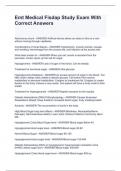Emt Medical Fisdap Study Exam With
Correct Answers
Ateriovenus shunt - ANSWER-Artificial device allows an artery to flow to a vein
without moving through capillaries.
Complications of renal dialysis - ANSWER-Hypotension, muscle cramps, nausea
and vomiting, hemorrhage from the access site, and infection at the access site.
What does insulin do - ANSWER-When you eat, insulin is secreted from the
pancreas. Insulin opens up the cell for sugar.
Hypoglycemia - ANSWER-Lack of sugar in the blood. Can be deadly.
Treatment for low blood sugar - ANSWER-Oral glucose.
Hyperglycemia (Diabetes) - ANSWER-An excess amount of sugar in the blood. Too
little insulin makes cells unable to absorb glucose. Cell switch from normal
metabolism to abnormal metabolism. It begins to breakdown fat. It begins to create
Ketone in the body. Ketone is very acidic. And patient will have a fruity smell to their
breath.
Treatment for Hyperglycemia - ANSWER-Rapidly transport to the hospital.
Diabetic ketoacidosis (DKA) Pathophysiology - ANSWER-Causes Kussmaul
Respirations (Rapid, Deep breaths) Increased blood sugar, fruity smelling breath.
Acidosis - ANSWER-The accumulation of acids in the body
High Blood Sugar long term effects - ANSWER-Blindness, Neuropathy(Nerve
Damage), Necrosis(tissue death), Lose Limbs, Kidney Problems Commonly silent
MIs
Hypoglycemic Crisis Blood Sugar level - ANSWER-Blood sugar Below 40
Hypoglycemia blood sugar level - ANSWER-Blood sugar 40-80
Normal Blood Sugar - ANSWER-Blood sugar 80-120
Hyperglycemia blood sugar level - ANSWER-Blood sugar 120-400
Diabetic Ketoacidosis (DKA) or hyperglycemic hyperosmolar nonketotic coma
(HHNC) blood sugar level - ANSWER-Blood sugar 400-800
Hyperglycemic Crisis blood sugar level - ANSWER-Blood sugar 800-up
, Hyperglycemia Signs & Symptoms - ANSWER-Kussmaul respirations (rapid, deep
respirations), Dehydration, as indications of dry warm skin "tenting". Sunken eyes. A
sweet or fruity odor or the breath, caused by Ketones. A rapid, weak pulse (tready) A
normal or slightly low blood pressure. Varying degrees of unresponsiveness.
Weakness, nausea, and vomiting. Polyuria (excessive urination), Polydipsia
(excessive thirst), Polyphagia (excessive eating) Restlessness, possibly progressing
to coma; abnormally slurred speech; unsteady gait(movement).
Hyperglycemia Caused by - ANSWER-Patient is not under medical treatment
Takes an insufficient amount of insulin,
Excessive eating
Undergoing stress that may cause infection, illness, overexertion, fatigue, or drinking
alcohol.
#1 cause of diabetic death in pediatrics - ANSWER-Cerebral edema caused by
hyperglycemia
Hypoglycemia Signs and symptoms - ANSWER-Pale, moist skin (Clammy
Diaphoresis sweating), Dizziness, headache, Rapid pulse, Normal to low blood
pressure, altered metal status, (Acting drunk mean, aggressive, confused, lethargic,
or unusual behavior.) Anxious or combative behavior, Hunger, Seizure, fainting, or
coma, weakness on one side of the body (may mimic stroke) Rapid changes in
mental status.
Hypoglycemic Crisis caused by - ANSWER-Taken too much insulin,
Taken a regular dose of insulin but has not eaten enough food,
Had an unusual amount of activity or vigorous exercise and used up all available
glucose
Diabetes patients Commonly - ANSWER-Do not take their insulin when they get sick
and go in to hyperglycemic crisis.
What is required to give oral glucose. - ANSWER-Patient can hold a glass of water
and sip it. Make sure the tube of glucose is intact and has not expired.
Aplastic crisis - ANSWER-A condition in which the body stops producing red blood
cells; typically caused by infection.
Diabetic Ketoacidosis (DKA) - ANSWER-A form of hyperglycemia in uncontrolled
diabetes in which certain acids accumulate when insulin is not available.
Endocrine Glands - ANSWER-Glands that secrete or release chemicals that are
used inside the body.




